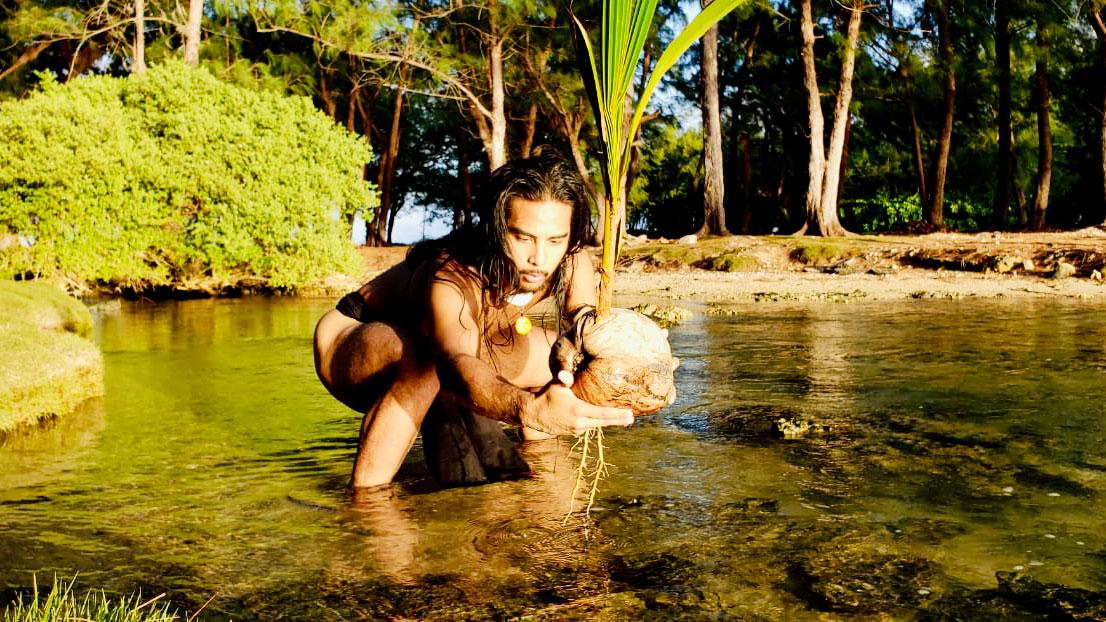Every year on July 21, people in the US territory of Guam commemorate “Liberation Day,” the day in 1944 when American forces invaded the island, retaking it from Japan at the end of World War II.
But for the Indigenous people of Guam — or Guåhan in the Chamorro Native language — Liberation Day, with its military parades and solemn speeches, is not a day to celebrate.
For Seattle-based dancer and musician Dakota Camacho, Liberation Day is full of contradictions.
Camacho, who uses they/them as pronouns, has been on a quest to understand the complexities of their Chamorro history. And along the way, Camacho developed a unique style of hip-hop and performance inspired by their ancestors.
Camacho’s paternal grandparents, who are Native Chamorro, lived through the US occupation prior to WWII as well as the Japanese occupation of Guam. When they later migrated to the Seattle area in Washington state, they faced a dire financial situation with nothing left to their name.
“And the complex part about it is that some people felt liberated. And some people did not feel liberated because they thought at least [they] knew where [they] stood with the Japanese, with the Americans [they] did not know.”
“And the complex part about it is that some people felt liberated. And some people did not feel liberated because they thought at least [they] knew where [they] stood with the Japanese, with the Americans [they] did not know,” Camacho said.
Japan invaded Guam on Dec.7, 1941, the same day that it attacked Pearl Harbor. Many were taken prisoner or killed during the occupation. Native Chamorro people faced the most suffering, with targeted internment, torture, rape and beheadings during the nearly three years of Japanese occupation.
Language has been a defining theme for Camacho. They learned very basic Native Chamorro language, mostly from their grandparents, who did not pass on the language to their own children out of fears of discrimination.
Now, Camacho is committed to drawing connections to their Indigenous roots.
Camacho incorporates Chamorro chanting in their performances and also works as an adjunct instructor and core researcher with the I Fanlalai’an Oral History Project based at the University of Guåhan.
Related: Forging new space: The multidimensional Afrofuturism of Sammus
Education is another defining theme in Camacho’s formation as an artist.
While reading history books about the treatment of Indigenous people after Columbus’ arrival in the Americas, Camacho discovered parallels with their own ancestors’ history in Guåhan.
“And then I came to find out that actually the horrible things the Catholic people did to the Arawak,” Camacho said, referring to the group of Indigenous peoples of South America and the Caribbean.
“Many of those atrocities — they did to our people,” Camacho said. “And I became obsessed because I realized that there was another world, where that didn’t exist. And that was the world before colonization.”
Related: The ‘strange grace’ of singer Arooj Aftab
Religion also plays a central role in Camacho’s work as an artist. Camacho, who grew up as a devout Catholic, said they struggled with faith in God because they knew their ancestors had a different set of beliefs.
‘“I really believed in spirit. I really believed in something that’s greater than me. And so I started asking my ancestors for guidance. How do I get to know about this world?”
‘“I really believed in spirit. I really believed in something that’s greater than me. And so I started asking my ancestors for guidance. How do I get to know about this world?” Camacho said.
A turning point came when Camacho discovered a mixed form of poetry and improvisation in their ancestors’ practice. “A form of rhyming improvisational freestyle, like, a kind of competitive wordplay,” Camacho said. “And I was like, ‘Well, I can’t speak my language, but I can speak the language of rhyme. There’s a world in which I can exist. So that’s what drew me into connection to hip-hop.”
